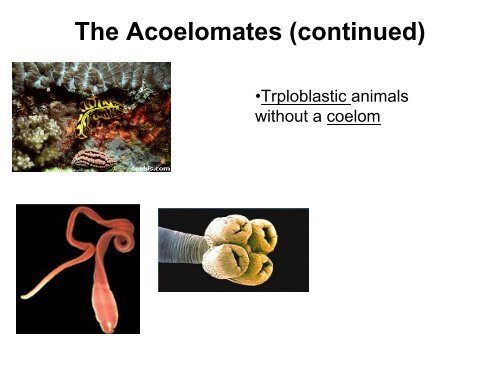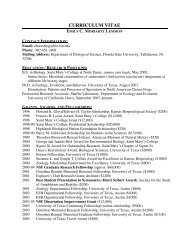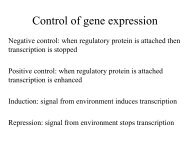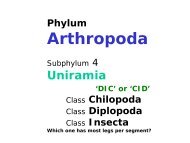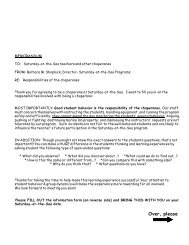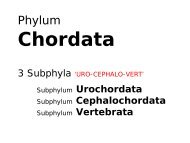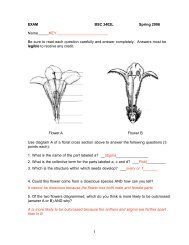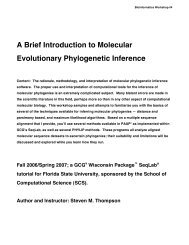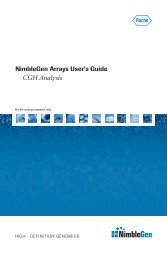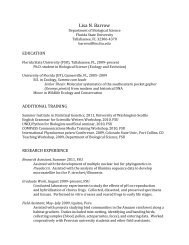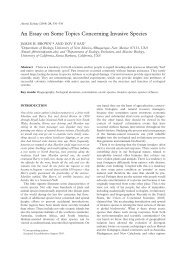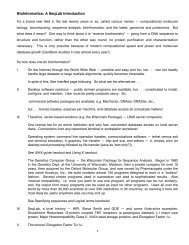Pseudocoelomates_2-8..
Pseudocoelomates_2-8..
Pseudocoelomates_2-8..
You also want an ePaper? Increase the reach of your titles
YUMPU automatically turns print PDFs into web optimized ePapers that Google loves.
The Acoelomates (continued)<br />
•Trploblastic animals<br />
without a coelom
Acoelomate Characteristics:<br />
No coelom<br />
What is a coelom?<br />
A body cavity that is<br />
completely surrounded by<br />
mesodermal tissue. A coelom<br />
is not open to the outside of<br />
the animal.
What is a coelom?
Acoelomate Characteristics:<br />
No coelom<br />
endoderm<br />
endoderm<br />
gut<br />
gut<br />
gut
Acoelomate Phyla<br />
1. Gnathostomulida<br />
2. Platyhelminthes<br />
3. Nemaertea
Phylum Nemertea<br />
the ribbonworms
Body Plan<br />
rhynchocoel<br />
proboscis<br />
anus<br />
rhynchocoel<br />
mouth
Body Plan<br />
gonads<br />
intestine<br />
proboscis<br />
rhyncocoel<br />
circular muscles<br />
longitudinal muscles<br />
nerve cord<br />
blood vessels
Feeding and Digestion<br />
Feeding<br />
– Free-living, carnivorous<br />
– Have an eversible proboscis that is not connected to<br />
the digestive system<br />
Proboscis: usually tipped with<br />
a stylet
Proboscis: not<br />
connected to the gut<br />
Pharynx: an<br />
extension of<br />
the gut
Feeding and Digestion<br />
Digestion<br />
– extracellular (in the intestine)<br />
– intracellular (by gastrodermal cells)<br />
– intestine is unbranched<br />
– complete system (mouth and anus)
Reproduciton<br />
Asexual<br />
– Most species are capable of reproducing asexually<br />
through fragmentation and regeneration<br />
Sexual<br />
- Most species are dioecious and have external<br />
fertilization
Reproduction<br />
gametes<br />
gonopre<br />
Fertilization is external:<br />
gametes are released through<br />
the gonopore. Eggs are laid<br />
in an egg capsule or burrow.
<strong>Pseudocoelomates</strong><br />
Triploblastic animals with a “false” coelom<br />
What is a coelom?<br />
A body cavity that is<br />
completely surrounded by<br />
mesodermal tissue. A coelom<br />
is not open to the outside of<br />
the animal.
<strong>Pseudocoelomates</strong><br />
Triploblastic animals with a “false” coelom (a<br />
pseudocoelom)<br />
What is a pseudocoelom?<br />
A body cavity that is<br />
surrounded by mesoderm on<br />
one side.
endoderm<br />
endoderm<br />
gut<br />
gut<br />
gut
<strong>Pseudocoelomates</strong><br />
There are 9 different phyla that are classified as<br />
pseudocoelomates.<br />
Nematoda<br />
Rotifera
Loricifera<br />
Kinorhyncha<br />
Nematomorpha<br />
Priapulida
Acanthocephala<br />
Gastrotricha<br />
Entoprocta
Pseudocoelomate<br />
Characteristics<br />
Organ level of organization<br />
Tissues are organized to for organs which are used<br />
to accomplish physiological functions
Pseudocoelomate<br />
Characteristics<br />
Triploblastic<br />
3 Germ Layers<br />
endoderm<br />
mesoderm<br />
ectoderm<br />
3 Tissue Layers<br />
gastrodermis<br />
mesoderm<br />
epidermis
Pseudocoelomate<br />
Characteristics<br />
the pseudocoelom<br />
ectoderm<br />
• is a closed, fluid filled cavity<br />
• contains digestive, excretory, and reproductive<br />
structures<br />
• the fluid within acts as a circulatory system<br />
• the fluid within acts as a hydrostatic skeleton<br />
against which the muscles work
Pseudocoelomate<br />
Characteristics<br />
Bilateral Symmetry<br />
• with anterior and posterior ends<br />
Cephalization<br />
• concentration of sensory organs in the<br />
head of the animal
Pseudocoelomate<br />
Characteristics<br />
Digestive System<br />
• complete<br />
• some regional specialization<br />
Circulation System<br />
• no system (or organs)<br />
• performed by the pseudocoelomic fluid
<strong>Pseudocoelomates</strong><br />
Nematoda<br />
Rotifera
Phylum Nematoda<br />
the roundworms
Phylum Nematoda<br />
• There are >12,000 species that are found in almost all<br />
habitats (marine, freshwater, underground, inside plants<br />
and animals, etc…).<br />
• They are also incredibly abundant. For example:<br />
• a m² of soil may contain >4 million nematodes<br />
• a decomposing apple may contain >90,000<br />
nematodes of a single species
Body Plan<br />
mouth<br />
pharynx<br />
nerve ring<br />
intestine<br />
excretory pore<br />
renette gland<br />
vagina<br />
ovaries<br />
anus
Feeding and Digestion<br />
Life Style<br />
– free-living<br />
– parasitic
Feeding and Digestion<br />
Digestion<br />
– complete system (have an anus)<br />
– some regional specialization (e.g. an<br />
esophagus)
Support and Locomotion<br />
Skeletal system<br />
- fluid in pseudocoelom acts as a hydrostatic<br />
skeleton
Support and Locomotion<br />
pseudocoelom<br />
endoderm<br />
ectoderm<br />
mesoderm
Support and Locomotion<br />
Cuticle<br />
– covers body (secreted by epidermis +<br />
composed mostly of collagen)<br />
– functions as a primitive external skeleton<br />
– must be molted for animal to grow
Support and Locomotion<br />
The cuticle appears to be<br />
segmented. However the<br />
external rings (annuli) do not<br />
correspond to internal<br />
segments.<br />
Nematode cuticle<br />
These external rings make the<br />
cuticle flexible and may help<br />
the cuticle grip the surface.
Support and Locomotion<br />
Locomotion<br />
– longitudinal muscles ONLY: they act against the<br />
cuticle and pseudocoel<br />
(results in “whiplike” motion)<br />
longitudinal muscles
Support and Locomotion
Support and Locomotion<br />
http://www.devgen.com/devpage/largeimage/wild.html
Nervous System<br />
Nervous system<br />
- entirely epidermal: all nervous tissue<br />
derivied from ectoderm<br />
- cephalization: nerve ring and labial nerves<br />
- dorsal and ventral nerve cords
Nervous System<br />
dorsal nerve cord<br />
labial nerves<br />
esophagus<br />
mouth<br />
ventral nerve cord<br />
nerve ring
Nervous System<br />
dorsal nerve cord<br />
ventral nerve cord
muscle cell body<br />
muscle cell arm<br />
nerve cord<br />
cuticle<br />
Nematode muscle cells are<br />
unique: they have “arms” that<br />
contact the nerve cord. In most<br />
species, nerve cells have<br />
processes that touch muscles.
Circulation/ Excretion<br />
Circulatory system<br />
– No system (no organs)<br />
– performed by fluid in pseudocoelom<br />
Excretion<br />
– Diffusion, or Renette glands
Reproduction<br />
Sexual<br />
– usually dioecious<br />
– often the sexes are sexually dimorphic<br />
(males and females look different)
Males often have a<br />
spicule<br />
at the end of their<br />
tail used to insert<br />
their sperm into the<br />
female<br />
Reproduction
Reproduction<br />
– internal fertilization<br />
– males have ameoboid sperm (nematodes are the<br />
only animals to have this kind of sperm)<br />
Ameoboid sperm
Parasitism<br />
• Many nematodes are important parasites of both<br />
plants and animals.<br />
parasite of<br />
soybean plants<br />
parasite of<br />
tomato plants
Parasitism<br />
Eye worm (Loa loa):<br />
• transmitted by fly bites<br />
• larvae go through bloodstream<br />
• adults live in subcutaneous tissue
Parasitism<br />
Intestinal roundworm (Ascaris):<br />
• transmitted by contaminated food<br />
• adults live in small intestine<br />
• it’s estimated that 20% of world’s population is<br />
infected (~1.3 billion people)
Parasitism<br />
Guinea worm (Dracunculus medinensis):<br />
• transmitted by infected copepods in drinking water<br />
• larvae move into the body cavity<br />
• female adult migrates to the subcutaneous tissue, causes an<br />
ulcer/blister, and releases eggs through hole when host comes in<br />
contact with water
Parasitism<br />
Guinea worm (Dracunculus medinensis):<br />
• traditionally removed by winding the worm around a<br />
matchstick over the course of several days
Parasitism<br />
Trichinella spiralis:<br />
• causes Trichinosis<br />
• transmitted by eating undercooked pork<br />
• juveniles encyst within host muscle cells<br />
juvenile<br />
Host<br />
muscle cell
Parasitism<br />
Heartworms (Dinofilaria immitis):
• The study of the model nematode Caenorhabditis elegans<br />
has resulted in important discoveries in genetics and<br />
development.
What is so special about C.<br />
elegans<br />
•It is a simple animal that shares<br />
many of the essential biological<br />
characteristics that are central to<br />
problems of human biology<br />
•It displays eutely: having an<br />
invariant and genetically fixed<br />
number of cells.<br />
•It’s genome has now been<br />
sequenced
Phylum Rotifera<br />
the rotifers
Body Plan<br />
corona<br />
mouth<br />
cerebral ganglion<br />
mastax/trophi complex<br />
intestine<br />
pedal glands<br />
foot
Feeding and Digestion<br />
– have a “crown” of cilia called a corona<br />
– the corona creates a<br />
current to bring food into<br />
the mouth
Feeding and Digestion<br />
– have a specialized feeding structure called the:<br />
mastax-trophi complex<br />
Mastax: a modified<br />
muscular pharynx<br />
Trophi: modified jaws<br />
within the mastax
Some of the trophi (jaws):
Feeding and Digestion<br />
Life Style<br />
– Free-living<br />
Digestion<br />
– complete system (have an anus)<br />
– some regional specialization (e.g.<br />
mastax-trophi complex)
Support and Locomotion<br />
Skeletal system<br />
- fluid in pseudocoelom acts as a<br />
hydrostatic skeleton<br />
Movement<br />
– the corona<br />
– pedal glands (adhesive), as well as<br />
foot and toe (spurs) for attachment<br />
to substrate
Physiology<br />
Nervous system<br />
- cephalization, cerebral ganglia<br />
- dorsal and ventral nerve cords<br />
Circulatory system<br />
– no system (no organs)<br />
– performed by fluid in pseudocoelom<br />
Excretion<br />
– protonephridia and flame cells<br />
– cloacal bladder (collects wastes)
Reproduction<br />
Sexual<br />
- complex life cycle with different types of eggs
Reproduciton<br />
Amictic eggs<br />
• diploid (mitotically produced)<br />
• can’t be fertilized<br />
• develop into diploid, amictic females
Reproduction<br />
Mictic eggs<br />
• haploid (meiotically produced)<br />
• produced after some sort of environmental stimulus<br />
(eg. high density, change in temperature)<br />
• if unfertilized, develop into haploid males<br />
• if fertilized, secrete a thick, protective shell until the<br />
environment is favorable again, after which they<br />
develop into diploid, amictic females
Mictic egg (haploid)<br />
not fertilized<br />
fertilized<br />
haploid<br />
diploid<br />
haploid male<br />
diploid females
Reproduction<br />
Sexual<br />
- complex life cycle with different types of eggs<br />
- In sexual species males often represent a<br />
small percent of the populaiton (< 1 %).<br />
- Males do not feed (no digestive system).
Reproduction<br />
Asexual:<br />
Parthenogenesis: unisexual reproduction where<br />
females produce offspring from unfertilized eggs,<br />
diploid eggs (virgin birth)
Bdelloid Rotifers<br />
The benefits of sex (from an evolutionary<br />
perspective):<br />
1. Purge mutations<br />
2. Create genetic variation (through recombination)
Bdelloid Rotifers<br />
Complete asexuality is generally thought to be an<br />
evolutionary dead end.<br />
There are very few organisms that are completely<br />
asexual.
Bdelloid Rotifers<br />
Bdelloid Rotifers:<br />
•Completely asexual<br />
•At least 45 million years<br />
old<br />
•4 families, 18 genera,<br />
and 360 described<br />
species
Bdelloid Rotifers<br />
How have Bdelloid Rotifers been able to be so<br />
successful when most completely asexual species<br />
go extinct quickly?


